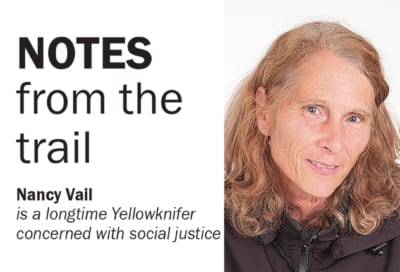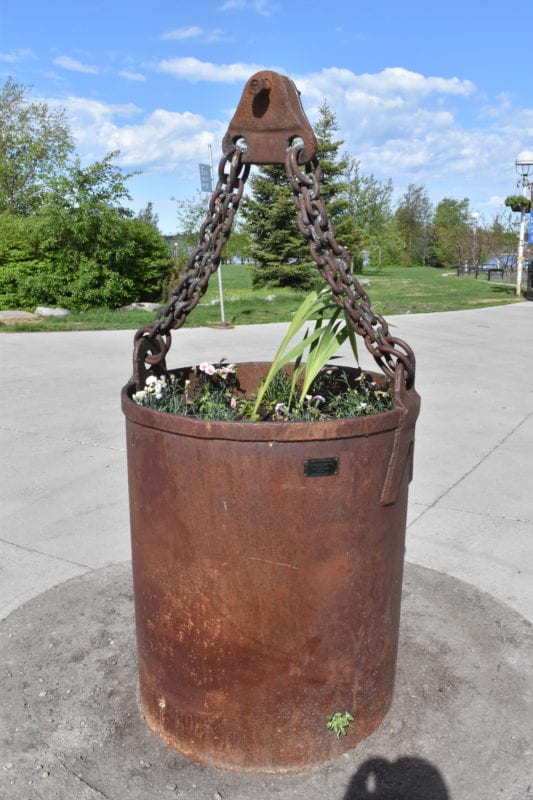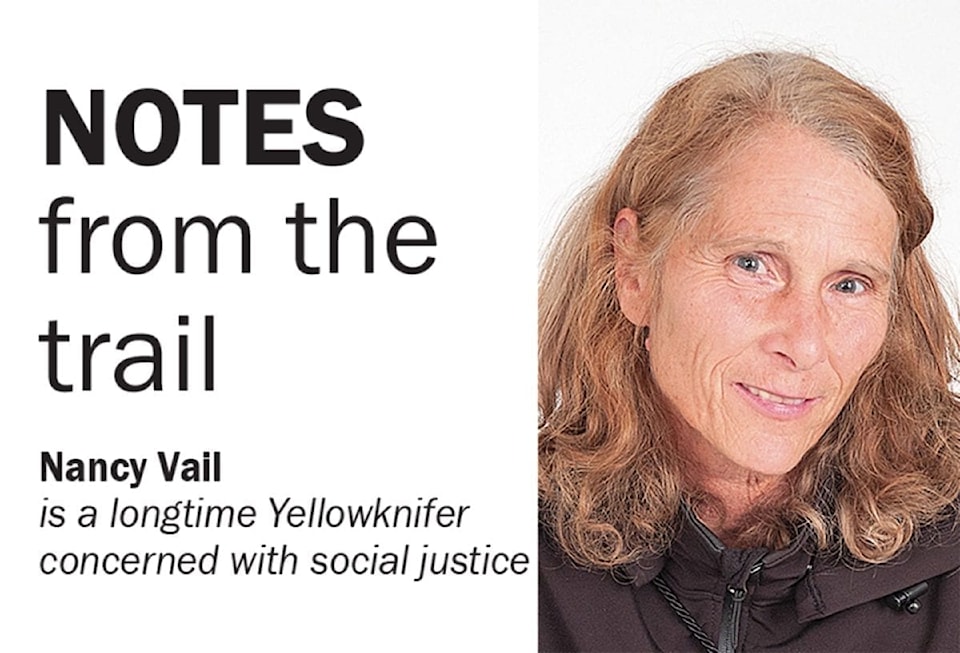I actually didn't notice the new installation on the sidewalk into Somba K'e park on Friday until a friend walked up with smoke coming out of both ears.
"What's the matter?"
"Well, I've been waiting for them to bring the muskox back but instead they replace it with an oversized, rusted out tin can!"
"Pardon?"
"Oh, I don't know. It's probably to do with mining but why would they put something like that on the main walk into the park? I mean, that muskox was beautiful. What happened to the muskox? And now we've got that?"
Peering over her shoulder I finally saw what she was talking about. It was some kind of bucket, an old relic from one of the mines. I'd missed it by taking the side entrance to city hall and when I finally did see it, I wasn't sure what it was.
I assured my friend that the beloved muskox would be back this week (which I have since confirmed with the city) but I couldn't assure her that they would be removing the mining bucket that was there now.
"And you should see, they have a bunch of mining stuff near the fire hall too."
"Really?" I felt my blood pressure rising. I haven't been out there for a few months so was not aware of anything new other than recent road construction.
"I don't remember seeing any notices or ads or stories in the paper inviting the public to have their say."
"I know. Me either. They just kind of showed up out of nowhere."

I was quite surprised by everything as I had met another friend in Somba K'e park earlier that afternoon, at 4 p.m. to be exact, and there was no installation then although because of the rather, um, subdued nature of this piece, I could have missed it.
"Wow," I said. "I'm amazed they didn't ask people for some comments. I didn't know the city had unilaterally declared Yellowknife a mining town."
As surprising as this, the installation appeared just days before Indigenous People's Day but with how much input from Yellowknives Dene First Nation who suffered so much from the gold boom? We know that several user groups have been involved in sensitive negotiations about what to do with the old Giant Mine site for many years and only recently made any headway. The Dene wanted the site left like the raw wound it is, skull and crossbones signs warning people to stay out – a stark reminder of its checkered past.
The first thing that had to be done was apologizing to the Dene whose world had been turned upside down when gold mining and miners came to the Yellowknife area some 80 odd years ago. Though the story dates back to the 1950s, many still wince about the Dene family that was given $750 to compensate for the loss of their child from arsenic poisoning thanks to Giant Mine.
Government personnel still monitor air and water quality daily to ensure that arsenic levels are not making us all sick. And the federal government is locked into shelling out millions of dollars every year to keep arsenic stored underwater, thus many dread an earth-shattering event that may damage those chambers.
So again, while these mining heritage installations may be interesting, with this unsettling past, I question why they were distributed without public notification. I have since learned that the pieces came from the now defunct visitors centre and as a favour to individual owners and the Yellowknife Heritage Society.
The city agreed to place them around town, at least temporarily. Whether temporary or permanent, though, their placement still needed public input. Considering what the Yellowknives Dene suffered because of mining on their land, anything having to do with mining or its remembrance must be done in conjunction with them. At a recent meeting, the Dene had shown some interest in opening an education centre on the old Giant Mine site where the good, the bad and the ugly of gold mining in the NWT could be told, which seems like a more honest way to recognize the role it played in the history of mining in the NWT.
Installing these pieces without historical contexts or input from all those affected, could prove to be another prickly colonial oversight. We don't need that now, not during this delicate time of truth and reconciliation.
Let's be inclusive and ensure that whatever adorns the city meets everyone's needs and works to heal, not exacerbate, old wounds.
